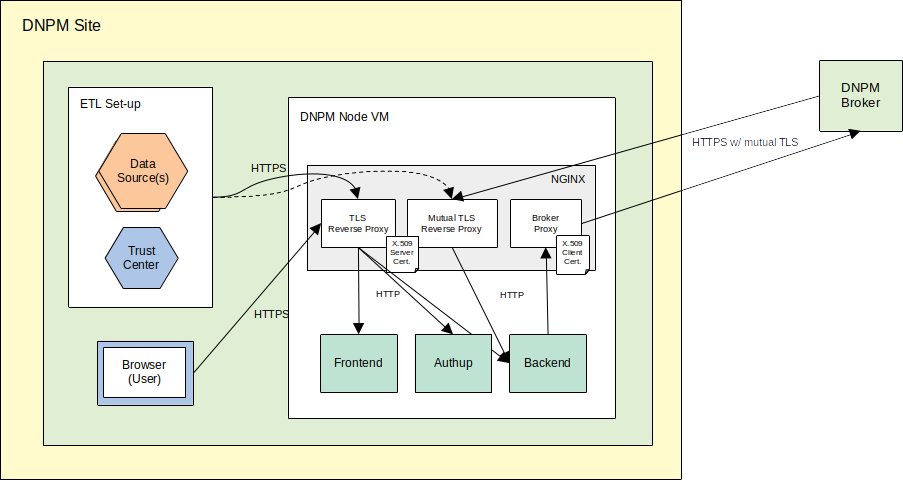WORK IN PROGRESS
- Docker / Docker Compose
- DFN Server Certificate issued for your DNPM:DIP node's FQDN
- Client Certificate issued by DNPM CA (see here for instructions to request one)
A template docker-compose.yml is available.
Basic configuration occurs via environment variables, for most of which default values are pre-defined. The only mandatory variables are
| Variable | Use/Meaning |
|---|---|
BASE_URL |
The base URL to your local DNPM:DIP node. In a production set-up, the hostname of (reverse) proxy behind which the components run (see below). In a (local) development/test set-up possibly http://localhost |
BACKEND_LOCAL_SITE |
Your Site, in format {Site-ID}:{Site-name}, e.g. UKT:Tübingen (see here for the overview list of Site IDs and names) |
TODO for You: Provide these variables via a file .env (see also here). Here's a sample:
BACKEND_LOCAL_SITE=UKx:SiteName
BASE_URL=https://dnpm.uni-x.deIf desired, the following variables CAN be set in the .env file to override the default values set in the docker-compose.yml:
| Variable | Use/Meaning |
|---|---|
AUTHUP_SECRET |
Secret (password) of the Authup Admin user |
MYSQL_ROOT_PASSWORD |
Password of the MySQL DB used in Authup |
BACKEND_CONNECTOR_TYPE |
Set to one of { broker, peer2peer } to specify the desired connector type (see below) |
BACKEND_AUTHUP_URL |
Base URL under which the Backend can reach Authup |
BACKEND_RD_RANDOM_DATA |
Set to a positive integer to activate in-memory generation of RD random data (for test purposes) |
BACKEND_MTB_RANDOM_DATA |
Set to a positive integer to activate in-memory generation of MTB random data (for test purposes) |
As shown in the system overview diagram above, the backend and frontend components are meant to be operated behind a reverse proxy. This handles TLS termination (including mutual TLS for API endpoints not secured by a login mechanism) and also acts as a forward proxy to handle the client certificate for mutual TLS on outgoing requests (see below about the Backend Connector).
The default/recommended set-up uses NGINX, for which a template configuration file nginx_tls.conf is available.
TODOs for You:
- In
docker-compose.ymlservicenginx, adapt the paths to the respective certificate and private key files. - In
nginx_tls.confAdapt the URL to the Broker in theserverblock acting as forward proxy to the Broker.
The following components/functions of the backend are configured via external configuration files.
Templates for these are available here.
These files are expected by the application in the directory bound to docker volume /dnpm_config in docker-compose.yml.
TODOs for You:
- In
docker-compose.yml: Bind the directory to contain config files tobackendservice volume/dnpm_config - Place files
production.conf,logback.xml,config.xmlinto this config directory
The Play HTTP Server in which the backend application runs is configured via file production.conf.
The template provides defaults for all required settings. In case the backend won't be addressed via a reverse proxy forwarding to 'localhost' (see below) but directly by IP and/or hostname, these "allowed hosts" must be configured explicitly:
...
hosts {
allowed = ["your.host.name",...]
}See also the Allowed Hosts Filter Documentation. Depending on the size of upload request payload, the size of the memory buffer might also have to be adjusted here:
http.parser.maxMemoryBuffer=2MBData persistence by the backend uses the file system.
TODO for You: In docker-compose.yml, bind the directory meant for this purpose to the backend service's docker volume /dnpm_data.
Depending on the permission set on this directory, you might have to explicitly set the system user ID for the docker process running the backend (see services.backend.user in docker-compose.yml).
Logging is based on SLF4J.
The SLF4J implementation plugged in by the Play Framework is Logback, which is configured via file logback.xml.
The default settings in the template define a daily rotating log file stored in sub-folder /logs of the docker volume bound for persistence (see above).
You might consider removing/deactivating the logging appender to STDOUT
The Backend application itself is configured via config.xml.
The main configuration item there is the type of Connector used for communication with external DNPM:DIP node peers.
This file's template shows example configurations for both possible connector types described below.
TODO for You: Delete the one not applicable to your case, and follow respective instructions below.
The connector for the hub/spoke network topology used in DNPM, based on a central broker accessed via a local Broker Proxy (see below). The connector performs "peer discovery" by fetching the list of external peers from the central broker. If desired, you can override the request time-out (seconds). Also, in case you prefer the nector to periodically update its "peer list", instead of just once upon start-up, set the period (minutes).
The connector based on a peer-to-peer network topology, i.e. with direct connections among DNPM:DIP nodes. Accordingly, each external peer's Site ID, Name, and BaseURL must be configured in a dedicated element, as shown in the template.
